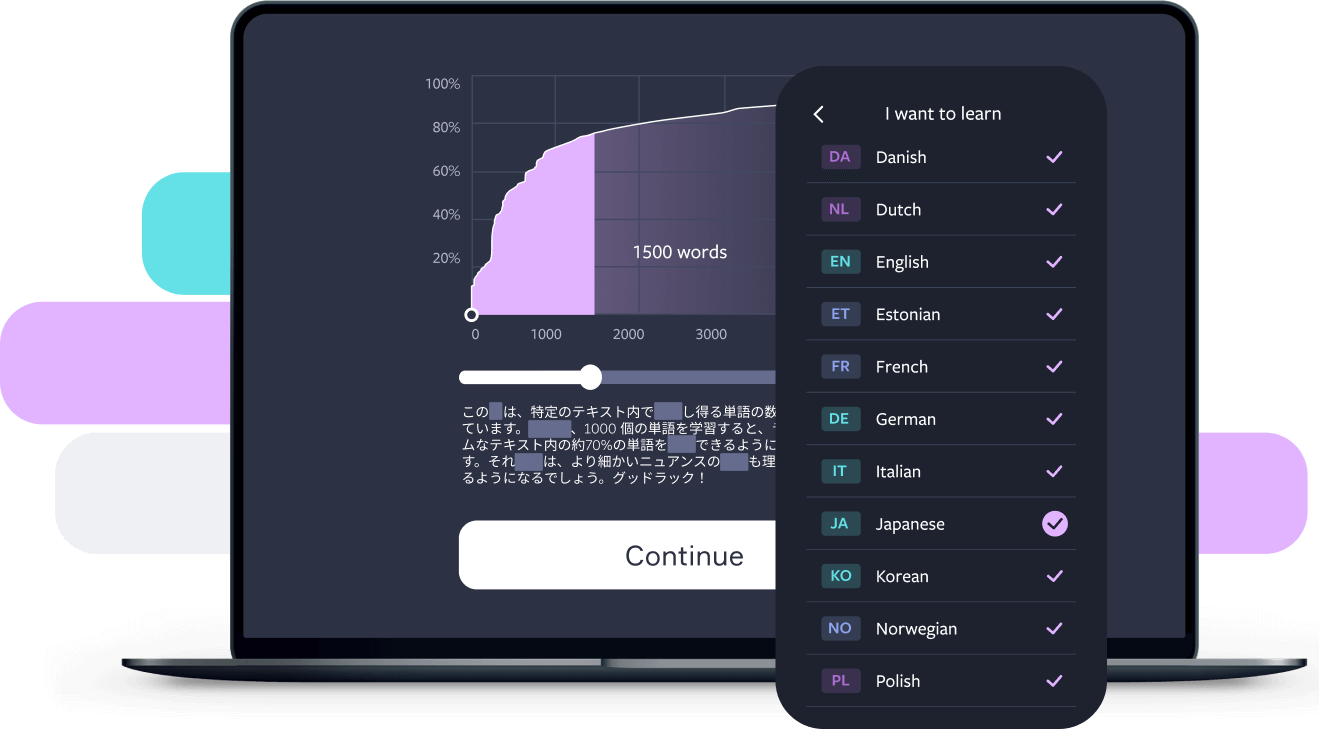Learn Japanese online faster than ever before
Learn the words that you really need, and improve your vocabulary in as little as 10 minutes per day.

app downloads
new words learned monthly
nationalities learning with Lingvist
The best way to learn Japanese

Learn Japanese Fast
Lingvist gets you to learn the things you need to, right when you need to learn them. You make fast progress by skipping material you don’t need to learn or practice.

Personalized Learning
Lingvist keeps learning relevant and suitably challenging for every learner. The program uses AI to map your knowledge and tailor the course around what you need to learn to progress quickly and effectively.

Study Japanese Focused
With Lingvist, there’s nothing extra to get in the way. What you study is based on what you already know and what you’ll use most, not what someone else says you should learn. Lingvist is designed to get you into a learning flow with no distractions. It’s like having a personal statistical analyst to provide you with insights into your strengths and what you need to work on.

Always Accessible
Take your language learning with you to make faster progress with bite-sized study sessions throughout the day – use the app while commuting, waiting in line, or taking your lunch break. Available on the web, iOS, and Android.

Start speaking Japanese fluently, fast.
Frequently Asked Questions About Learning Japanese Online
How long does it take to learn Japanese?
The time it takes to learn Japanese varies widely among learners, but according to the US Foreign Service Institute, it typically takes around 2200 hours for English speakers to reach proficiency. This estimate, however, can vary, as numerous factors influence the learning process. These include your native language, any other languages you speak, the amount of time dedicated to studies, and your overall commitment to the learning process. What can make Japanese difficult to learn is their writing system, grammar, and pronunciation, which are quite different from English.
What is the best way to learn Japanese?
When choosing the right learning method for yourself, you need to consider your learning style, goals, and interests.
- Writing systems – You should start by first learning hiragana and katakana, which are relatively easy to learn. After you’ve fully learned these, you can move on to learning kanji and focusing on the easiest ones. Lingvist has hiragana and katakana decks that teach you how to type them on a keyboard.
- Structured learning – Use a language learning app like Lingvist, which can help you stay motivated and on track to help you learn new words, provide feedback, and track your progress.
- Immersion – Immerse yourself in the language through Japanese media. Watch Japanese dramas, movies, or anime, listen to J-pop, or follow Japanese YouTubers. This helps with listening skills and understanding cultural nuances.
- Practice speaking – Find language partners who you can practice with. Practicing with a native speaker can really help with your listening and speaking skills.
- Be consistent – Regular, daily practice is more effective than occasional long sessions. That’s why learning with Lingvist is a great way to improve your Japanese. You only need 10 minutes of daily study with Lingvist to start seeing your Japanese skills improve rapidly.
How to learn written Japanese?
Japanese has three different writing systems: hiragana, katakana, and kanji. Learning all of them may seem daunting if you’re just a beginner starting to learn Japanese, but it’s an important step toward fluency in Japanese. With the right approach and consistent study, you can definitely learn the Japanese characters. Here’s how you can approach learning each:
Hiragana is used for native Japanese words and grammatical elements. Of the three writing systems, this one is the easiest to learn. Use apps like Lingvist to help you memorize the characters. Practice writing them and pay attention to the stroke order.
Katakana is used to write foreign names and words or sometimes to emphasize the words. You can use the same methods for learning katakana as you used for learning hiragana. With katakana, you’ll be able to read even more Japanese.
Kanji are characters borrowed from Chinese. There are thousands of them, however, so learning them will be a longer process. Lingvist is a great place to start, because you’ll begin with the easiest kanji and move on to more difficult ones gradually.
How can I learn Japanese by myself?
If you’d like to learn Japanese on your own, then there are many options and methods to choose from. You should choose one that fits your learning style and schedule best, but if you haven’t decided yet, here are a few options that could help you learn Japanese on your own:
- Listening – Immerse yourself in the Japanese language as much as possible to train your listening skills. Watch Japanese TV shows and movies, or listen to Japanese audiobooks, podcasts, or music.
- Reading – Another immersion method is to read books, news articles, and blog posts in Japanese. It’s good to start with topics you already know or are interested in; that way it will be easier for you to grasp the topic under discussion.
- Language learning apps – Mobile apps offer interactive lessons and the ability to practice on the go. By using a language learning app like Lingvist, you can improve your Japanese skills with only 10 minutes of daily study.
- Make learning Japanese fun for yourself – Learning a language requires dedication and persistence. You can stay motivated by setting goals, tracking your progress, and rewarding yourself for achieving milestones.
Is Japanese easy to learn?
Learning Japanese can be quite challenging, especially for native English speakers, as the writing systems, grammar structure, and pronunciation patterns differ significantly from English. However, with dedication, effective learning strategies, and consistent practice, you are sure to reach fluency in Japanese. Here are some factors that might make Japanese more difficult than other languages:
- Writing system – Japanese has three different writing systems: hiragana, katakana, and kanji. Hiragana and katakana are phonetic characters that each represent 46 different sounds. Kanji are characters that have been borrowed from Chinese.
- Grammar structure – Japanese has a very different grammar structure when compared to English. It uses a subject-object-verb (SOV) word order, which is different from English’s SVO structure. Additionally, Japanese has particles that indicate grammatical relationships between words, which can be challenging to grasp at first.
- Pronunciation – Japanese pronunciation can be challenging for English speakers, as there are sounds that do not exist in English. Additionally, Japanese has pitch accents, which means that the pitch of your voice can change the meaning of a word.
Hopefully, these points haven’t scared you away from learning Japanese. It is a beautiful and expressive language that opens up a rich culture and history. With the right approach, you can achieve fluency in Japanese in no time at all.
What makes Lingvist’s Japanese course so special?

CUSTOM COURSE LEVELS
Lingvist analyzes your existing knowledge of the Japanese language to place you at the right level. This means that you can get started with the course content that’s appropriate for your level right away.
JAPANESE GRAMMAR TIPS
Grammar is an important part of learning any language, which is why we offer grammar tips that are relevant to every sentence you are learning.
REMEMBER WHAT YOU LEARN
Lingvist uses proven techniques inspired by cognitive theory, such as spaced repetition. This will help you easily remember the words you’ve learned when you need them. Long-term recall of new vocabulary is the key to speaking Japanese more fluently.
SPEAK WITH CONFIDENCE
Tired of typing all of those new words over and over again? Try our voice input feature and practice using your Japanese pronunciation. Lingvist has voice recognition technology specifically designed for learners, so you can practice your new Japanese vocabulary free from anxiety or embarrassment.
LISTEN AND LEARN
Lingvist provides plenty of opportunities to listen, not just read, reinforcing the Japanese rules of pronunciation. Keep your headphones on to learn the sounds and intonational flow of Japanese, then practice repeating the words.
SEE AND FEEL YOUR PROGRESS
Lingvist will keep track of what you’ve mastered, so that you can see your own progress. Watch the number of words you can actively recall grow in personalized stats as your Japanese level advances.


Practice daily
Setting and achieving attainable goals, like 10 minutes of Japanese practice per day, have also been shown to boost your overall mood! Within a few months, you’ll be amazed at the progress you’ve made.

Make it immersive
The best way to get comfortable with Japanese is to try to switch your brain into “Japanese mode” by creating an immersive Japanese environment. Listen to Japanese radio while making dinner or Japanese podcasts during your commute.

Remember why you started
Remembering why you decided to start this journey will help you establish sustainable learning habits. If you feel a dip in motivation, return to that initial reason to refocus your priorities.

